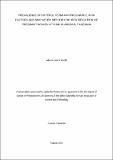| dc.description.abstract | Hyperglycemia in pregnancy is increasing in Tanzania; however, timely diagnosis is limited.
This study therefore, aimed to establish the prevalence of hyperglycemia in pregnancy, risk
factors and develop a simple method for identification of women with gestational diabetes
mellitus in Tanzania. A cross-sectional study was conducted in Arusha City, between March
and December, 2018 among 468 pregnant women at second and third trimesters. Blood
glucose was tested using Gluco-Plus™ and the World Health Organization’s criteria, while
insulin resistance was calculated using the Homeostasis Model of Assessment formula.
Anthropometrics were assessed using standard procedure and knowledge on hyperglycemia
in pregnancy, demographics, and maternal characteristics were collected through face-to-face
interviews using a questionnaire. The prevalence of hyperglycemia in pregnancy was 16.2%
(n = 76) of which 13% had gestational diabetes mellitus and 3.2% diabetes in pregnancy.
Additionally, the prevalence of insulin resistance was 21% (n=49). Knowledge about
hyperglycemia in pregnancy was low on existence (10.7%, n=50), effects (23%, n=14),
symptoms (26%, n=13) and risk factors (30%, n=15). Hyperglycemia in pregnancy was
significantly associated with body fat percentage ≥ 38, delivery macrosomic babies, insulin
resistance, mid-upper arm circumference ≥ 28 cm and family history of type 2 diabetes
mellitus. These risk factors, except insulin resistance, were used to develop a risk score which
was simplified into risk factors checklist to identify women with gestational diabetes
mellitus. The score correctly identified 98% of hyperglycemic women, with an area under the
receiver operating characteristic curve of 0.971 (95% CI 0.955-0.993, p < 0.001), sensitivity
of 0.980 and specificity of 0.458. The high prevalence of hyperglycemia in pregnancy creates
a need for regular screening and management. Hence, the developed screening method can be
validated for use when resources are limited to give priority to high risk women while
planning for universal screening. | en_US |


